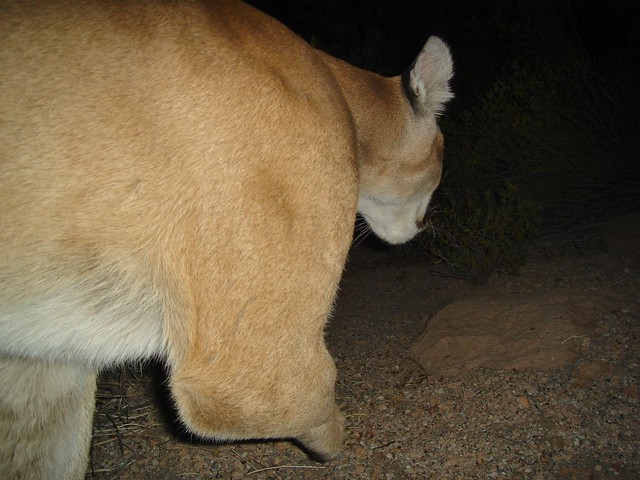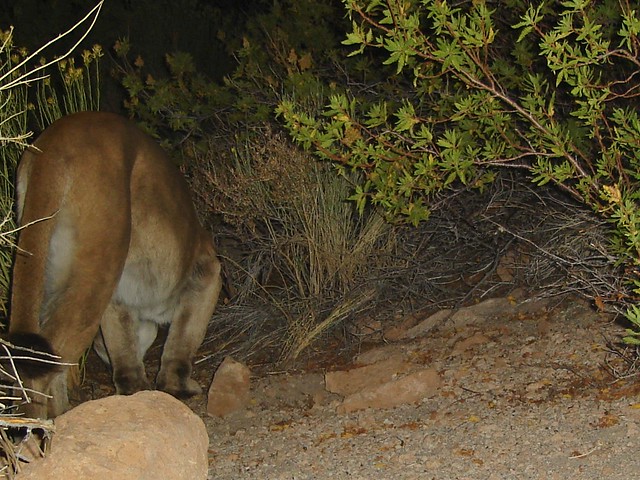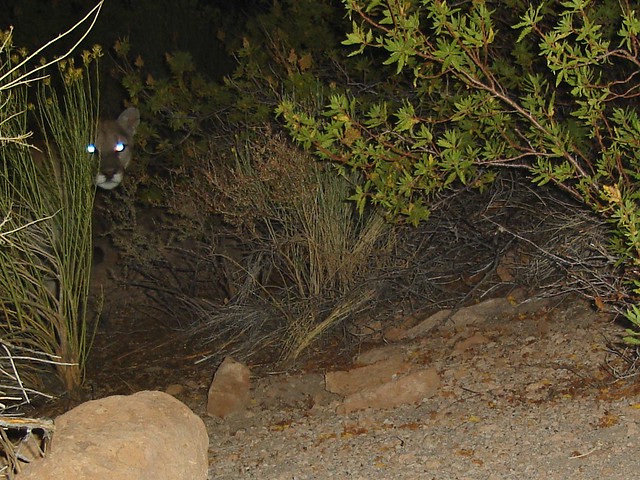Bringing us to the question that led to this post: what's wrong with this picture?

Unless you're a friend in-the-know, or a close reader of my Mono-specific mumblings, the answer may not be obvious. Because it lies in what's missing - a GPS tracking collar.
As mentioned in past posts, to help rebuild the endangered Sierra Nevada Bighorn Sheep population, pretty much all the California lions from Bodie to Bishop and beyond have GPS collars, are actively monitored, and even "herded" away from the sheep. Courtesy of Cal Fish & Game.
But lions in Nevada, just 30 miles away from my Mono Basin survey site, don't have collars.
Hmmmm... 30 miles is much less than 60 miles or 100 or 663...
About 1/2 of young female lions disperse. But even then, females don't generally disperse as far, since they tend to have smaller home ranges that often overlap with their neighbors. I.e., lady lions are more social and friendly. Shocker, that.
Male lions, however, are "obligate dispersers" - which in biogeek-speak and lionese means they gotta hit the road or Dad (and Mum) will kick their lazy ass something fierce. And continuously. The parents just don't want the competition. Plus, it helps with gene dispersal.
And as we can see from this second photo, our collarless stray does happen to be a boy-o:

While GPS collars are amazingly useful for tracking individual and localized transit patterns - genetic sampling is starting to reveal even bigger animal-picture details, such as the macro movements over generational time and much grander topographies.
A key aspect of these large-scale genetic flows is their "source-sink dynamics." Sources being fonts of species supply, and sinks being sponges of population demand. The typical causes of sources, sinks and patterns between are the usual suspects: food and water availability, habitat quality, predation and hunting pressure, land development, topographic barriers, etc.
However, there are anomalies that counter good source-sink edu-guesses. The eastern Sierra Nevada seems to be one. Researchers at the University of Nevada that tested genetic samples of 739 lions from Nevada and eastern CA had predicted the Sierra would be a source of lions, since there's more cats there than in the Nevada ranges next door. I.e., their reasonable theory was that lions would disperse towards Nevada's open, more easily occupied territories.
But the data are showing the opposite - more lions are coming to CA from NV than going the other way. Appears pumas prefer to live (and can live) in higher densities in the Sierra, where water and deer are more plentiful (and yes, no one hunts them), over the spacious, yet arid mountains and canyons of Nevada's west-side. Queue music and finger-snapping.



So, if you are a migrant from Nevada - welcome to Cali, young cougar dude.
Paradise found.
But ya better get ready bro - the Bighorn collar-crew is looking for you.
==
Ooh, ooh, ooh, ooh
Ooh, ooh, ooh, ooh
Black and orange stray cat sitting on a fence
Ain't got enough dough to pay the rent
I'm flat broke but I don't care
I strut right by with my tail in the air
Stray cat strut, well, I'm a ladies cat
I'm a feline Casanova, hey man that's that
Get a shoe thrown at me from a mean old man
Get my dinner from a garbage can
I don't bother chasing mice around
I slink down the alley, looking for a fight
Howling to the moonlight on a hot summer night
Singing the blues while the lady cats cry
"Wow stray cat, you're a real gone guy
I wish I could be as carefree and wild
but I got cat class and I got cat style"
- Stray Cats, "Stray Cat Strut"
====
References:
- A. Andreasen, K. Stewart, W. Longland, J. Beckmann, M. Forister - Molecular Ecology, Aug 2012 - Identification of source-sink dynamics in mountain lions of the Great Basin
- Our Amazing Planet - Mountain Lions Migrating West to California
- KQED - Truly CA - Counting Sheep
- California Department of Fish & Game - Bighorn Sheep Recovery Program
- Nature of a Man (this blog) - Smelly Cat
- Nature of a Man (this blog) - Always Put Collars on Your Kitties
- Nature of a Man (this blog) - posts on cam trapping the Mono Basin
- Stray Cats - Greatest Hits, including Stray Cat Strut

Congrats, you met the challenge of catching a no-collar kitty! For his sake, I hope he's not collared. I have mixed feelings about killing mountain lions to "save" bighorn sheep - they're not just "herded" away, they're actually killed according to one of your reference links above. I wonder if mountain lion predation actually helps long-term robustness of bighorn sheep populations by selectively killing off individuals that otherwise may pass on less than fit genes (sorry, may be ignorant and totally not biologicalese).
ReplyDeleteYour post made me remember an article I read a year or two ago about cam traps and jaguars in the SW. I tried to find it but instead found information about the death of Macho B and the story behind wistleblower Janay Brun. OK, I'm depressed. Must. Get. Outside.
One last note, we again had a couple mountain lion sightings here in town in and around the McD's parking lot. The joke was it was going for a late-night BigMac.
Thanks Katie. Yes, they do kill some lions. It's a tough call and trade-off. The research suggests that limiting predation is the fastest way to get to self-sustaining sheep herds that won't require that kind of intervention/care, but lions, as you point out, should be eating the sheep, and while not rare/endangered, aren't super numerous in CA (~5,000).
DeleteSo, knowing that the folks directly working on the bighorn are some of the best from CA and NV universities, I defer, respect their call and hope they're being realistic about the recovery. No one wants to be killing lions if the sheep can't ever get to self-sustainability.
Mtn lion sightings around your local McD's, huh? Did anyone check to see if maybe that franchise switched to serving roadkill venison burgers to cut costs? ;)
This bit about killing mountain lions to save bighorns still nags me, especially considering hunting is allowed for the desert bighorn sheep population. I perused the recovery plan this morning, and the questions I had as I was reading it were poorly addressed in the comment section with misdirection. I wonder why Baxter showed such a high mountain lion predation count - more sheep to begin with or were they diseased and easier prey? I suspect translocation of 103 sheep to extirpated areas (an estimated 41% of the entire known population at the time was moved to areas that obviously could no longer sustain bighorn sheep=incredibly dumb idea!) over the course of 8 years had a greater impact on the Sierra population reduction than any mountain lions. Like I've said on my blog, I think us humans like to play God and are unwilling to acknowledge our culpability when our best intentions go awry. Since we can't change the weather, habitat, or nearby disease spreading domesticated sheep, let's resort to the old-school thinking of killing off predators. Ugh! Oh, do you happen to know what the "aversive conditioning" of mountain lions actually entails?
DeleteWe are changers of our environment, so we are always playing God, IMO. We put the Sierra bighorn on the brink of extinction, and now we're trying to press Undo. The lions are collateral damage. Desert bighorn aren't endangered, however, and don't need the protection - their populations - over 4k in Southern CA alone - are handling predation just fine.
DeleteThe difficulty is that lions are really good at what they do, and have a tendency to fixate on a single species. One lion, left unchecked, could take 10-20 sheep a year. One lion. And last I heard, there's less than 400 Sierra bighorn, so it doesn't take too many of those hits to keep the herds from growing.
I believe "aversive conditioning" is part of the "herding" I mentioned. When the GPS data suggests a cat is following sheep, local trackers, generally on horseback and with dogs, run the lion away from the bighorn. This, unfortunately, sometimes goes sideways for lions and dogs, which is another downside.
It was great being there when check the photos on that cam. Congrats on the find.
ReplyDeleteI second Codger's sentiments. Pretty exciting to get the "rare" uncollared cat. But I must also add that this was an excellent post. So much good information that I was not aware of before. The movement of cats from Nevada into California instead of the other way around is a little counter-intuitive, but their reasoning makes sense.
ReplyDeleteI would be really interesting to compare the true hunting pressure from humans within the Basin. I know Mt. Lion hunting is not legal in CA, but some level of poaching of lions is occurring. Is the level of poaching+legal hunting in Nevada significantly higher than in CA and could this be playing a major factor in their dispersal pattern. Of course this study would be pretty hard to do, because there will be a lot of inherent uncertainty in the data when poaching levels have to be estimated, but it would be very interesting. For all I know this study has already been done, but I am not aware of it.
One could also imagine that just like the banditos of early California the canyons and mountain ranges of the Sierras provide better cover from gun-toting posses than the much more open habitat of the Basin proper.
Thanks dude. I agree - it would be a fascinating study if you could find a way/place to properly isolate hunting pressure versus no hunting from all the other variables. Btw - aside from poaching in CA, there's also depredation for fear, pet and domestic animal eating, and, for eating Bighorn sheep, so perhaps the differences in NV hunting vs. CA poaching/depredation isn't all that much.
DeleteAs for the banditos thought - it said in the paper that the lions in NV don't live in the flatlands - only the mtns and cyns, so that variable shouldn't be a huge factor in the comparison.
Good point on the canyons. I agree with you about depredation for the other reasons may be similar (legal) but not sure if the illegal killing for those same reasons are the same, but they very well might be. I guess Eastern Sierra probably has more of a "NV" outlook on that than I associate with a slightly more predator tolerant CA, but I am probably giving my home state too much credit. The depredation does bring up another issue especially with the bighorns. It at least seems possible that when the agency kills an established male it leaves open a territory that can be filled by a wandering male, so maybe depredation may even encourage immigration to some extent in comparison to other close by territories that are rarely vacant.
DeleteWow. So I live in NY and perhaps you're familiar with the COMPLEX that people have here in the NE: that our state agencies are stocking Mt. Lions here, but it's all on the down low. People claim to "see" these cats all the time, esp on camera trap images. There is no mistaking these cats, in my opinion, for anything else. Especially since our only established wild cat (besides feral) is the bob! Awesome pictures.
ReplyDeleteThanks Alyssa. Be careful about those claims though - I've had multiple occasions when I've seen a spike in traffic to one of my cougar posts or photos, only to track it back and see it referenced in some east coast forum or blog post about a "lion photo" from a lousy b&w trail cam, that to my pretty experienced eye, is obviously a house/feral cat.
DeleteOh yes, I'm aware. I write a wildlife blog for the NY capital region as well, and I've been getting pictures sent to me of cougars "seen" in NY. A few minutes on Google, and they can be found to be out-of-state (out of NY that is) kitties. I'm of the camp that we do not have a self-sustaining pop of Cougars here.
ReplyDelete